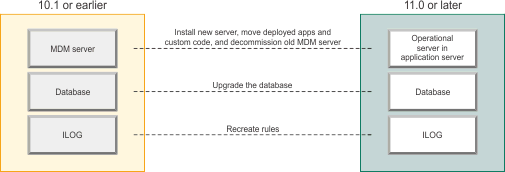A set of steps describes the process of upgrading from InfoSphere® MDM Server to InfoSphere MDM.
About this task
This section provides instructions for upgrading InfoSphere MDM Server database and enterprise application.
Upgrading your MDM environment often requires assistance from members of your own organization as well as IBM Services or an IBM consulting partner. Do not upgrade your implementation without first identifying the team and relying on guidance from that team.
InfoSphere MDM release 11.0 introduced several large-scale architecture changes to the InfoSphere MDM Server product. The updated architecture uses an OSGi framework (Open Services Gateway initiative) in which you can install, start, stop, and update component bundles without rebooting the system. The bundles, which are referred to as component bundle archives (CBAs) create an architecture that is service-oriented, enabling InfoSphere MDM to work within evolving enterprise service-oriented architectures.
By contrast, InfoSphere MDM Server users had to open, alter, and repackage the application EAR file to deploy the data model and any customizations. In the OSGi framework, users deploy such customizations as independent CBAs that communicate with the application without requiring changes to the application module itself.
The new OSGi architecture also means that the embedded ILOG® engine is no longer available. Instead the ILOG engine (now called ODM) can be called remotely. You can determine whether you use ILOG rules with your installation of InfoSphere MDM Server by running a script provided with the new version of InfoSphere MDM. You may want to recreate those rules in ODM. The existing rules cannot be exported.
Note that the management of configuration information changes significantly with the new version of InfoSphere MDM. In previous releases, configuration data was maintained within XML files embedded within the JAR files whose code the configuration settings controlled. The Configuration Manager read from the XML files and wrote the configuration settings into the CONFIGELEMENT table in the database. With the latest InfoSphere MDM release, configuration data is stored exclusively in the CONFIGELEMENT table. The XML files are no longer a part of configuration management.
The latest version also includes security improvements compared to InfoSphere MDM Server. Upgrade scripts included with the product configure the new installation to use the legacy security mode. To take advantage of the new security mode after upgrade, disable the TrustedClientMode setting within the CONFIGELEMENT table.

